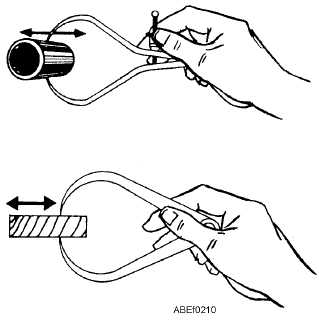Outside calipers for measuring outside diameters
are bow-legged; those used for inside diameters have
straight legs with the feet turned outward. Calipers are
adjusted by pulling or pushing the legs to open or close
them. Fine adjustment is made by tapping one leg
lightly on a hard surface to close them, or by turning
them upside down and tapping on the joint end to open
them.
Spring-joint calipers have the legs joined by a
strong spring hinge and linked together by a screw and
adjusting nut. For measuring chamfered cavities
(grooves) or for use over flanges, transfer calipers are
available. They are equipped with a small auxiliary leaf
attached to one of the legs by a screw (fig. 2-9). The
measurement is made as with ordinary calipers; then
the leaf is locked to the leg. The legs may then be
opened or closed as needed to clear the obstruction,
then brought back and locked to the leaf again, thus
restoring them to the original setting.
A different type of caliper is the hermaphrodite,
sometimes called odd-leg caliper. This caliper has one
straight leg ending in a sharp point, sometimes
removable, and one bow leg. The hermaphrodite caliper
is used chiefly for locating the center of a shaft, or for
locating a shoulder.
USING CALIPERS
A caliper is usually used in one of two ways. Either
the caliper is set to the dimension of the work and the
dimension transferred to a scale, or the caliper is set on
a scale and the work machined until it checks with the
dimension set up on the caliper. To adjust a caliper to a
scale dimension, hold one leg of the caliper firmly
against one end of the scale and adjust the other leg to
the desired dimension. To adjust a caliper to the work,
open the legs wider than the work and then bring them
down to the work.
CAUTION
Never place a caliper on work that is
revolving in a machine.
Measuring the Diameter of Round Stock or the
Thickness of Flat Stock
To measure the diameter of round stock or the
thickness of flat stock, adjust the outside caliper so that
you feel a slight drag as you pass it over the stock. (See
fig. 2-10.) After the proper "feel" has been attained,
measure the setting of the caliper with a rule. In reading
the measurement, sight over the leg of the caliper after
making sure the caliper is set squarely with the face of
the rule.
Measuring the Distance Between Two Surfaces
To measure the distance between two surfaces with
an inside caliper, first set the caliper to the approximate
distance being measured. Hold the caliper with one leg
in contact with one of the surfaces being measured.
(See fig. 2-11.) Then, as you increase the setting of the
caliper, move the other leg from left to right. Feel for
the slight drag indicating the proper setting of the
caliper. Then, remove the caliper and measure the
setting with a rule.
Measuring Hard-to-Reach Dimensions
To
measure
an
almost
inaccessible
outside
dimension, such as the thickness of the bottom of a cup,
use an outside transfer firm-joint caliper as shown in
2-5
Figure 2-10.—Using an outside caliper.
Figure 2-11.—Measuring the distance between two surfaces
with an inside caliper.




